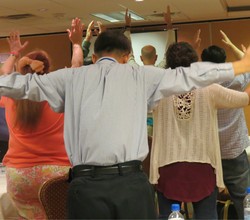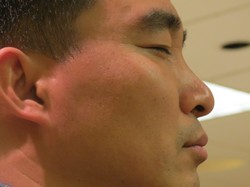After two days of teaching on solitude and silence, conference goers heard these words, from the Sermon on the Mount, as they resonated throughout the room:
“Whenever you pray, go into your room, close the door, and pray to your Father in secret.” (Matt. 6:6 NET)
Presbyterian Pastor B. J. Woodworth finished reading the rest of the short section on prayer, where Jesus encourages the listening crowds to pray with few words.
After a brief moment—you could hear the pause—he told those gathered for the Disciple-Making Conference that the purpose of solitude and silence is prayer.
“The men and women in early Christian history who withdrew to the desert devoted themselves to prayer,” he said. “They didn’t just do this so they could be alone and quiet. Their purpose was to be alone with God and to listen to and for God.”
Woodworth said this was the purpose Jesus pursued as well. “Almost always Jesus was seeking intimacy and connection with God, the voice of his Father. This became the source of his leadership and power.”
In the Gospels, especially John’s, we see that the fruit of Jesus’ prayer life was union with God.
“He was always listening to what the Father wanted him to do,” Woodworth said, “so he knew he was acting in God’s purposes. They were perfectly united with one another.”
Woodworth then shifted gears, reading from 2 Peter 1:4, which speaks about those receiving the promises of Christ becoming “partakers of the divine nature.”
Acknowledging that the topic makes him a little nervous, he spoke about the theology of the desert fathers, who believed that God became human so that humans could become god.
“Notice it was a small g; we are not all becoming God,” Woodworth said. “But I believe we Presbyterians sell short the intimacy and connection in divine reality we can have.”
Woodworth pointed out that there are moments when we can see, know and do what God is asking us to do—just as Jesus did.
“We dwell within that beautiful dance of God the Father, Son and Holy Spirit,” he said. “All morning we sang, ‘Come, Holy Spirit, fill us.’ The same Spirit that raised Jesus—that Spirit connects with our spirit.”
“What does it mean that we have become participants in the divine nature of the Trinity?” Woodworth asked before turning it over to his wife, Katrina.
A yoga teacher and instructor, Katrina Woodworth practices yoga as a spiritual discipline—focusing on healing body, mind and spirit. She led conference goers in a body prayer, using these words from St. Patrick:

Conference goers felt Christ was with them as they participated in a body prayer. —Paul Seebeck
Christ with me, Christ before me, Christ behind me,
Christ in me, Christ beneath me, Christ above me,
Christ on my right, Christ on my left
As Sharon Cole, of First Presbyterian Church in Gillette, Wyoming, participated in the prayer, she found herself saying, “Wow.”
“I actually had a feeling that Christ was with us in all the different places, as we moved our bodies to those words,” Cole said. “It became more than an idea.”
“As we moved, it reinforced the fact that God is with me,” added Roberta Gunning, of Hope Presbyterian Church in Omaha, Nebraska.
Katrina Woodworth says body prayer works because we are engaging our whole selves—and cells—in prayer.
“Western culture is so mind dominated; other cultures worship with their bodies,” she said.
“When we introduce worshiping with one’s body, we find people are no longer sleeping but awake. The movement creates memory, which helps them come alive.”
This year’s Disciple-Making Conference, “Living the Way: Foundations of Discipleship,”
concludes today.

